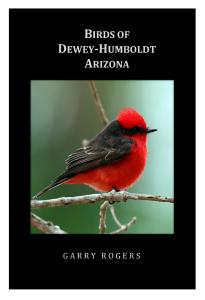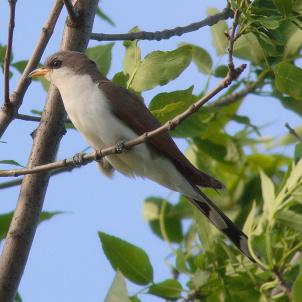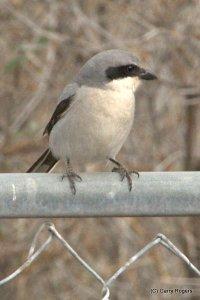 There is a new book on the birds of Dewey-Humboldt, Arizona. The book has photographs, notes on seasonal abundance, and conservation status for the 127 species I’ve seen around my home on the Agua Fria River in the center of town.
There is a new book on the birds of Dewey-Humboldt, Arizona. The book has photographs, notes on seasonal abundance, and conservation status for the 127 species I’ve seen around my home on the Agua Fria River in the center of town.
My place is on the edge of a small 20-acre willow-cottonwood forest growing along the Agua Fria River. The forest is the dark green patch in the lower right-center of the header photograph. The river is perennial through the forest and there are large stock-watering ponds that are now used only by wildlife. Without houses or trails in its core area, the forest is a safe zone for wildlife. Thousands of birds stop to rest and forage, and many spend their summers there. Rare birds such as the Southwest Willow Flycatcher, Common Black Hawk, and Gray Hawk build nests and raise families.

Yellow-billed Cuckoo by mdf
In August, 2016, Felipe Guerrero identified the calls of mature Yellow-billed Cuckoos near the edge of the forest and we photographed a fledgling. Western North American populations of the Cuckoo are in steep decline. The species is rare in central Arizona where I live, and rarer still to be producing fledglings here.
The final version of the book will be in print next month. Advance review copies in PDF format are available. Please download a copy and give me your feedback.
>>Download Birds of Dewey-Humboldt, Arizona.
Preparing The Book
In 1997, I began making lists of the birds and other wildlife I saw around my 20-acre farm on the Agua Fria River in the town of Dewey-Humboldt, Arizona. After a few years, I gathered the lists together in one notebook. While doing this, I researched the various species groups (birds, grasshoppers, mammals, etc.) and compiled lists of all the species known to live in or to visit Arizona. The Arizona Wildlife Notebook, published in 2014, includes lists of all those species categorized in eleven groups (amphibians, ants, birds, butterflies and moths, dragonflies and damselflies, fish, grasshoppers and other singing insects, lizards, mammals, snakes, and turtles). The book gives common and scientific names and estimates of species health and stability. It’s a handy tool for recording species anywhere in the State of Arizona.
Birds of Dewey-Humboldt Arizona, is a chapter from the full notebook with added details and photographs for observed species. The book is a report to my community that I hope stimulates others to record their bird sightings.
I recommend uploading bird sightings to the online checklist program at http://ebird.org. Operated by the Cornell Lab of Ornithology and National Audubon Society, eBird provides basic information on bird abundance and distribution at various spatial and temporal scales. Placing sightings on the eBird website will help ornithologists and other naturalists working on bird conservation.
This book has common and scientific names alphabetized by common name, and it has an index. Finding a bird name can be tricky because the common name isn’t always what we think. For instance, the list gives Arizona’s two Robin species as “American Robin” and “Rufous-backed Robin.” The index is often more helpful. For Robins, it lists the species as “Robin, American” and “Robin, Rufous-backed.” It also gives page numbers for both species’ scientific names.
Caveat: My notes on dates of first sightings probably reflect the date I learned to identify a species, not the date the species first appeared near my home.
Protecting Birds
The past decade’s droughts, storms, and spreading deserts show that humanity is changing the Earth. Research coming from many sources shows that worldwide animal extinctions are occurring 100 times faster than in Earth’s previous mass-extinction events recorded in the fossil record.
Extinction isn’t the only concern. Total loss of a species results after years of decline. The Living Planet Index, which measures abundance levels of 14,152 monitored populations of 3,706 vertebrate species, shows that a worldwide crash is occurring. On average, monitored species declined by 58% between 1970 and 2012.

Loggerhead Shrike
One of the oldest and most familiar citizen-participation activities is the Audubon Society’s Christmas Bird Count. Wildlife biologists have used the Bird Count to monitor bird species populations. A recent analysis of the Count’s results show that many U.S. bird species are declining. Some of our most familiar birds appear in current counts less than half as often as they did just 50 years ago. For example, over the past 50 years, sightings of Loggerhead Shrikes, a common Arizona species, declined by 72%. The Shrike in the photograph at left is the only one I have seen in 19 years of watching at my place.
Arizona Game and Fish Department (AZGFD) wildlife biologists conclude that at least 58% of Arizona’s native birds are definitely declining and . Another 20% are of possible long-term concern. The U.S. Endangered Species Act protects only 1% of Arizona bird species.
The reason for the declining numbers is not a mystery. Researchers have shown that the declines are due to the impact of human activities, chiefly:
- habitat destruction (building and farming)
- resource harvests (logging, livestock grazing, and water diversion)
- habitat deterioration caused by introduced invasive plants
- habitat poisoning with pesticides, toxic wastes, and in the case of the oceans, acidification due to CO2 increases and increases in organic runoff from the land.
The human impact is a direct result of human construction, land clearning, and resource consumption. Our total global population is nearing 7.5 billion and we are using the Earth’s renewable resources faster than natural processes replenish them.
Unless we control our population and consumption or unless drought, disease, pollution, and rising temperature control them for us, the environmental impacts of our growth will eventually eliminate upwards of 80% of our bird species.
I believe nature conservation was the great challenge of the 20th Century, and we failed the challenge. Human beings are imposing a mass extinction that now appears destined to wipe out most animals on Earth. I hope readers of this book will recognize the danger and help me find ways to stop the extinctions.
Bird Species Numbers
According to the information published by AZGFD, 551 bird species and subspecies occur in Arizona. Regular residents number 451.
- World estimate: 10,000
- U.S. estimate: 1,000
- Arizona total: 551
- Arizona birds regularly present: 451
- Arizona regulars of concern (S1 to S3): 260 (58%)
- Arizona regulars of possible long-term concern (S4): 95 (21%).
- ESA Arizona regulars listed endangered: 6 (1%)
- ESA Arizona regulars listed threatened: 1 (<1%)
- ESA Arizona regulars of concern: 26 (6%)
Book Details
- Title: Birds of Dewey-Humboldt, Arizona
- Pages: 128
- ISBN-13: 978-1539511786 (CreateSpace-Assigned)
- ISBN-10: 1539511782
- BISAC: Nature / Birdwatching Guides
- List Price: $24.95
- Description: This book describes the birds seen around the author’s home in the center of Dewey-Humboldt, a small Arizona town. A desert stream, the Agua Fria River, passes through the town and across land owned by the author. At the confluence of two small tributaries, the river flood plain supports a 20-acre willow-cottonwood forest. Without houses or trails in its core area, the forest is a safe zone for wildlife. Thousands of birds belonging to more than 100 species stop to rest and forage in the small forest. The Southwest Willow Flycatcher (on the U. S. Endangered Species List) and several other rare bird species use the forest to build nests and raise families. The book lists 127 species observed in and around the forest. For each, the book includes seasonal abundance, conservation status, and a photograph.
- The book will be available from:
- Independent Bookstores
- Gifts and Games, Humboldt Station, Humboldt, Arizona
- Hastings Entertainment, Prescott, AZ
- Jay’s Bird Barn, Prescott, AZ
- Old Sage Book Shop, Prescott, AZ
- Peregrine Book Company, Prescott, AZ
- Prescott College, Prescott, AZ
- Internet
- Createspace
- Amazon
- Barns and Noble
- Independent Bookstores

